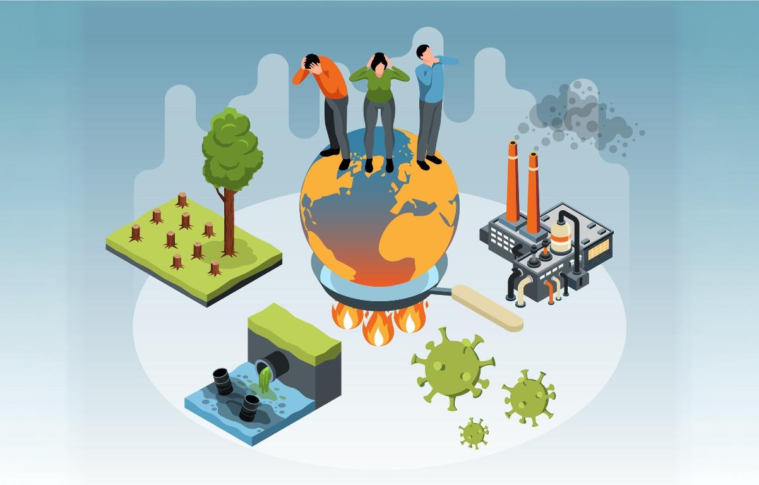AI technologies are transforming the way we approach the climate crisis. By leveraging machine learning, predictive analytics, and automation, AI provides novel solutions to reduce emissions, optimize energy consumption, and improve climate monitoring. This case study explores how AI is being utilized to tackle climate change, focusing on energy optimization, carbon capture, climate modeling, and disaster response.
Background
The urgency to combat climate change has never been greater. With rising global temperatures, extreme weather events, and environmental degradation, nations around the world are looking for innovative solutions to reduce their carbon footprints and increase resilience. AI is emerging as a powerful tool in this fight, helping industries, governments, and organizations optimize processes, predict future climate trends, and create actionable solutions for climate mitigation.
Key Areas Where AI Can Address Climate Change
1. Energy Optimization and Efficiency
AI is playing a pivotal role in optimizing energy usage in industries, buildings, and homes, helping to reduce greenhouse gas emissions. By using AI-powered systems to monitor energy consumption patterns, organizations can identify inefficiencies and make real-time adjustments to minimize waste.
- Example: Google’s DeepMind and the use of AI in energy management at Google data centers have been groundbreaking. By applying machine learning to monitor and adjust cooling systems in real-time, Google achieved a 40% reduction in energy usage for cooling. This helped the company move closer to its goal of operating fully on renewable energy.
- Impact: AI-powered systems like DeepMind have the potential to transform energy-intensive sectors by dramatically reducing energy consumption, which is one of the largest contributors to carbon emissions. Smart grid systems powered by AI also help optimize the distribution of energy from renewable sources, ensuring efficiency and minimizing energy loss.
2. Climate Modeling and Predictions
AI can enhance climate models by processing vast amounts of environmental data, such as temperature, humidity, ocean currents, and CO₂ levels. These models predict future climate conditions and extreme weather events, helping governments and organizations take preventative measures.
- Example: IBM’s Green Horizons project uses AI to predict air pollution in cities, allowing local governments to take timely action. AI models are trained on historical environmental data to forecast pollution levels and identify trends, providing early warnings for health and safety measures.
- Impact: AI improves the accuracy and timeliness of climate predictions. For example, AI-driven climate models can predict temperature rise, sea-level rise, and the occurrence of extreme weather events like hurricanes and floods, giving communities and governments the opportunity to prepare in advance.
3. Carbon Capture and Emission Reduction
AI technologies are being applied to monitor and optimize carbon capture processes. By improving the efficiency of carbon sequestration systems, AI can help reduce atmospheric CO₂ levels and mitigate the impacts of greenhouse gases.
- Example: Carbon Clean Solutions, a company focused on carbon capture technology, uses AI to optimize industrial carbon capture processes. Their AI-powered system analyzes emissions data from various industrial plants and provides real-time feedback to improve the efficiency of the carbon capture system.
- Impact: AI can enhance the performance of carbon capture technologies, making them more cost-effective and scalable. This is crucial for large-scale adoption in industries such as cement, steel, and power generation, which are major sources of CO₂ emissions.
4. Smart Agriculture for Sustainability
Agriculture is both a contributor to climate change and a sector vulnerable to its effects. AI can support sustainable agricultural practices by optimizing crop management, water usage, and soil health.
- Example: In India, the startup CropIn uses AI and data analytics to improve agricultural practices. Their platform collects data from farms and uses AI to predict crop yields, identify disease outbreaks, and optimize irrigation practices. By reducing water usage and preventing crop loss, AI helps make agriculture more resilient to climate change.
- Impact: AI-driven agricultural solutions promote more efficient land use, reduce waste, and ensure better resource management, all of which contribute to a smaller carbon footprint. Precision farming techniques, powered by AI, optimize the use of fertilizers, pesticides, and water, reducing environmental impact.
5. Disaster Response and Climate Resilience
AI plays a critical role in disaster preparedness and response by analyzing data to predict natural disasters, assess damage, and optimize emergency response efforts.
- Example: In the aftermath of natural disasters like hurricanes, AI systems powered by satellite imagery and real-time data can be used to assess the damage and help in recovery efforts. AI models are being used to predict the path of wildfires, hurricanes, and floods, providing governments and first responders with critical information in real-time.
- Impact: AI helps reduce the impact of climate-related disasters by improving early warning systems, optimizing evacuation plans, and ensuring that resources are deployed where they are needed most. AI can also be used to monitor recovery efforts and assess the success of mitigation measures.
6. AI for Carbon Footprint Tracking
Tracking and reducing carbon emissions are essential components of climate change mitigation. AI can automate the process of tracking and reporting carbon footprints in industries, businesses, and individuals, providing actionable insights for reducing emissions.
- Example: AI-powered platforms like Carbon Trust’s Footprint Calculator use AI to help businesses calculate their carbon emissions. By analyzing a company’s operations and activities, AI can identify key areas for emission reductions and suggest more sustainable practices.
- Impact: AI makes it easier to calculate and monitor carbon footprints, empowering businesses and consumers to make informed decisions about their environmental impact. By automating the process, AI helps reduce human error and provides real-time updates to support continuous improvement.
Case in Focus: Microsoft’s AI for Earth Program
Microsoft’s AI for Earth program is an ambitious initiative aimed at using AI to address environmental challenges, with a focus on climate change. The program provides access to Microsoft’s cloud computing resources and AI tools to nonprofit organizations, researchers, and businesses working on environmental solutions.
Implementation:
- Microsoft partnered with organizations like The Nature Conservancy and the World Wildlife Fund (WWF) to apply AI in tracking deforestation, predicting climate impacts, and assessing biodiversity.
- AI is used to process large datasets and satellite imagery to detect changes in ecosystems, identify areas at risk of environmental degradation, and predict future trends in land use.
Outcomes:
- The AI for Earth program has led to significant improvements in environmental monitoring and conservation efforts. For example, AI models have successfully predicted areas at high risk for deforestation, enabling conservation groups to take early action.
- Additionally, AI-driven tools are being used to monitor and protect endangered species, track pollution, and optimize natural resource management.
Challenges in Applying AI to Climate Change
- Data Availability and Quality: AI models rely on vast amounts of accurate and reliable data, which can be a challenge in certain regions, particularly in developing countries.
- Computational Power: AI models, especially those dealing with large datasets like climate simulations, require substantial computational resources, which can be costly and energy-intensive.
- Scalability: While AI has proven successful in pilot projects, scaling these solutions to a global level remains a challenge due to infrastructure, financial, and logistical limitations.
Recommendations for Scaling AI Solutions for Climate Change
- Collaboration Across Sectors: Governments, businesses, and non-governmental organizations (NGOs) should work together to share data, resources, and expertise in developing AI solutions for climate change.
- Investment in Green AI: As AI technologies grow, it is essential to ensure that the computational resources required for AI applications are powered by renewable energy to avoid exacerbating carbon emissions.
- Policy and Regulation: Governments should establish policies and regulations that encourage the adoption of AI for climate solutions while ensuring ethical use and data privacy protections.
Conclusion
AI offers tremendous potential for addressing climate change, from energy optimization to disaster response and carbon capture. By using advanced algorithms, predictive models, and real-time data analytics, AI can help reduce emissions, improve climate resilience, and accelerate global efforts to mitigate the effects of climate change. However, challenges related to data availability, computational power, and scalability need to be addressed to fully realize AI’s potential in combating climate change. Through continued innovation and collaboration, AI can become a cornerstone of global climate action.



